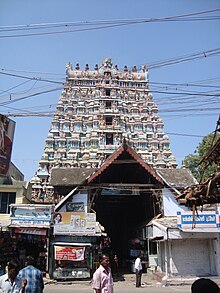| Nellaiappar Temple | |
|---|---|
Tirunelveli | |
 | |
| Religion | |
| Affiliation | Hinduism |
| District | Tirunelveli |
| Deity | Nellaiappar (Shiva) Kanthimathi Amman (Parvati) |
| Festivals | Aani Brahmostavam, Aadi Puram, Avani Mula Utsavam, Puratasi Golu Darbar, Aippasi Tirukalyanam, Aippasi Visu, Kandha Shasti, Karthikai Tiruvananthal, Margali Tiruvathirai, Thai Pusam Tirthavari, Thai Amavasya, Masi Shivaratri, Panguni Uttiram, Chittirai Pournami Tirthavari, Vasanthostavam, Vaikasi Shirabhishegam, Koratham, Vishakam. |
| Features |
|
| Location | |
| Location | Tirunelveli |
| State | Tamil Nadu |
| Country | India |
| Geographic coordinates | 8°43′42.4″N 77°41′19.4″E / 8.728444°N 77.688722°E |
| Architecture | |
| Type | Tamil architecture |
| Creator | Early Pandyas, Medieval Cholas |
| Completed | 700 CE |
| Direction of façade | East |
| Website | |
| http://kanthimathinellaiappar.tnhrce.in/ | |
The Nellaiappar Temple is a Hindu temple dedicated to the deity Shiva, located in Tirunelveli, a city in the South Indian state of Tamil Nadu. Shiva is worshipped as Nellaiappar (also called Venuvananathar) represented by the lingam and his consort Parvati is depicted as Kanthimathi Amman. The deity Vishnu is also worshipped here, having witnessed their wedding according to legend. Hence, this temple is regarded as an abhimana kshetram of Vaishnavism. The temple is located on the northern banks of Thamirabarani River in Tirunelveli district. The presiding deity is revered in the 7th century Tamil Saiva canonical work, the Tevaram, written by Tamil saint poets known as the nayanmars and classified as Paadal Petra Sthalam.
The temple complex covers an area of 5.9 hectares (14.5 acres) and all its shrines are enclosed with concentric rectangular walls. The temple has a number of shrines, with those of Swamy Nellaiappar and his consort Sri Kanthimathi Ambal being the most prominent.
The temple has three six rituals at various times from 6:00 a.m. to 9:00 p.m., and six yearly festivals on its calendar. Brahmotsavam festival during the Tamil month of Aani (June–July) is the most prominent festival celebrated in the temple.
The original complex is believed to have been built by Pandyas, while the present masonry structure was added by Cholas, Pallavas, Cheras, and Madurai Nayaks. In modern times, the temple is maintained and adminIstered by the Hindu Religious and Charitable Endowments Department of the Government of Tamil Nadu.
